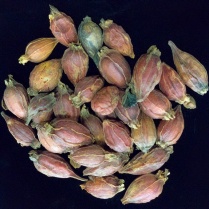Victor Albert studies tandem gene duplication in Gardenia jasminoides

“The important principle is that plants can reinvent things. They can duplicate some parts of their genetic toolkit and twiddle the functions a little.” Victor Albert, Professor, Department of Biological Sciences. Read the news article by Charlotte Hsu.
Research News
Plants are marvelous chemists, as the gardenia’s DNA shows
Gardenia jasminoides. In a new study, researchers report sequencing the species’ genome. Photo: YW Low
By CHARLOTTE HSU
Published June 22, 2020 This content is archived.
Plants are some of nature’s most extraordinary chemists. Unlike animals, they can’t run from predators or pathogens. They can’t uproot themselves to seek out a mate or spread their seeds.
So instead, they manufacture chemicals: toxins to kill bacteria. Bitter alkaloids to ward off herbivores. Sweet nectar and jewel-colored pigments to draw in pollinators or birds that can help disperse seeds.
Chemicals, you could say, are one of a plant’s ways of making love and war.
But how did trees, shrubs and flowers obtain these capabilities?
In a new study, scientists explore this question through the evolution of the gardenia, Gardenia jasminoides, an evergreen shrub with white flowers that’s planted as an ornamental in the tropics.
Researchers sequenced the genome of the gardenia for the first time. Then, they looked in-depth at how the plant makes a compound called crocin. This brightly colored chemical, which gives saffron its vermillion hue, is also responsible for the red-orange shade of the gardenia’s ripened fruits.
The study identified the genes involved in making crocin and used them to create the compound in the lab. This work — which included deciphering the step-by-step process that gardenias use to synthesize crocin — lays the foundation for large-scale production of the chemical, which is thought to have medicinal properties as an antioxidant.
The research also explored the origins of crocin in gardenias. The findings, which were published June 18 in BMC Biology, highlight the power of an evolutionary process called tandem gene duplication, in which accidental copying of DNA gives organisms flexibility to expand the arsenal of genetic tools they have at their disposal. It’s just one way that plants can evolve new capabilities, but it’s a crucial one.
“The important principle is that plants can reinvent things,” says study co-author and UB biologist Victor Albert. “They can duplicate some parts of their genetic toolkit and twiddle the functions a little. So let’s say you have a screwdriver, but the head is a super-big one. Imagine you could duplicate that screwdriver, but you could grind the head to make it smaller and useful for little screws, but you also still have the original one with the big head to handle large ones. That’s what these plants are doing.”
“It was exciting to uncover these molecular ‘tricks of the trade’ while researching the genome of a plant so important to traditional Chinese medicine, and now to modern biomedical research as well,” says the study’s co-corresponding author, Jingyuan Song, from the Engineering Research Center of Chinese Medicine Resource in China, who is also affiliated with the Chinese Academy of Medical Sciences and Peking Union Medical College.
The project was led by Song and Shilin Chen from the Engineering Research Center of Chinese Medicine Resource and China Academy of Chinese Medical Sciences, and by Giovanni Giuliano of the Italian National Agency for New Technologies, Energy and Sustainable Economic Development. The first authors were Zhichau Xu and Xiangdong Pu, both of the Chinese Academy of Medical Sciences and Peking Union Medical College. Xu is also affiliated with the Engineering Research Center of Chinese Medicine Resource.
Albert, professor of biological sciences, UB College of Arts and Sciences and a visiting professor at Nanyang Technological University in Singapore, and his students made important contributions, conducting bioinformatics research that helped unravel the evolutionary history of crocin and caffeine synthesis in the gardenia and coffee plants, respectively.
Dried fruits of Gardenia jasminoides. A chemical compound called crocin gives the fruits their red-orange hue. Photo: YW Low
How doubled DNA expands genetic toolbox
In a tandem duplication event, a single gene gets replicated by mistake during reproduction. Then, as a species evolves over time, the excess DNA is free to mutate and take on new functions.
In Gardenia jasminoides, tandem duplication led to the evolution of a gene that is needed for crocin synthesis, the study concludes. This form of genetic replication also enabled a close relative of the gardenia — the coffee plant Coffea canephora — to develop caffeine-producing genes, according to the research, which compared the gardenia’s DNA to that of Coffea canephora and a few other plants.
“This is a case where we see the same underlying evolutionary mechanism generating these tandem duplicates to create two different biosynthetic pathways of interest in two plants,” Albert says. “We have coffee and gardenia, which evolved from a close common ancestor, and in one case tandem duplicates formed and went crazy in coffee to make caffeine. And in the other, they formed and went crazy in gardenia to make crocins.”
Made by plants, but useful for humans, too
Crocin is found not just in gardenias, but also in the crocus plant, which produces saffron. These species didn’t inherit the ability to make crocin from a common ancestor: They evolved their arsenal of genes independently. The same goes for caffeine genes in coffee, tea and chocolate plants.
“Plants are playing games with multiple evolutions of interesting phytochemicals,” Albert says. “And, of course, all of these phytochemicals are useful to the plants, maybe in fighting against pathogens or serving as attractants to insects.”
When it comes to gardenias, the fiery color of the plant’s fruit helps to extend the species’ range, helping to attract animals that eat the fruits and expel the seeds in new locations.
But while plants perform chemistry for their own good, the compounds they produce can benefit humans, too. Aspirin is closely related to a compound found in willow bark. Digoxin, used sparingly to treat heart problems, comes from the foxglove plant. Crocin’s antioxidant properties are of interest to researchers, and now scientists have the knowledge they need to make that chemical in the lab.
“It’s a known fact that the same chemical (for instance, caffeine, or crocin) can appear again and again in distant plant species,” says co-corresponding author Giuliano. “One outstanding question was: How do the genes involved in the biosynthesis of such chemicals appear all at once in these different species? The work we published not only describes for the first time the complete pathway to crocin biosynthesis in any plant, but also shows that the pathway evolved in gardenias through the appearance of just one gene that acts early in the pathway, while the later ones were pre-existing and were hitchhiked for making crocin. This is an elegant demonstration, at the biochemical level, of how nature reuses and adapts pre-existing mechanisms, rather than creating completely novel ones.”
The research was funded by the National Natural Science Foundation of China, the Chinese Academy of Medical Sciences Innovation Fund for Medical Sciences, E.U. DISCO grant, Lazio Region project ProBioZaff, and the U.S. National Science Foundation.


